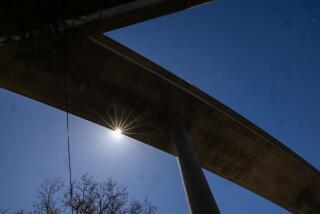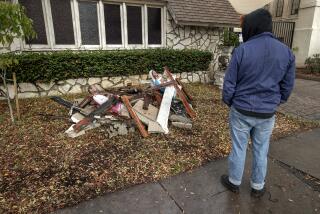Rocks of Faith
- Share via
Want to buy a piece of the rock? Not insurance, but a tiny piece of limestone from the rocky mass that surrounds Bethlehem’s Cave of the Nativity, where church tradition says Jesus was born.
A Beverly Hills socialite and her family hope Christians around the world will eventually exhaust their supply of at least a million “nativity stones” being encased in jewelry and selling for as much as $395.
For the record:
12:00 a.m. Oct. 16, 1996 For the Record
Los Angeles Times Wednesday October 16, 1996 Valley Edition Metro Part B Page 3 Zones Desk 1 inches; 29 words Type of Material: Correction
Stones--A story Saturday on the sale of jewelry containing stones taken from the area where Christian tradition holds that Jesus was born misrepresented the religion of Jeff Lowden. He is Roman Catholic.
“We want to get rid of all the stones,” Diane Keith said at a plant in Burbank that fashions the silver and gold pins, crosses and rosaries around the stones. About 200,000 pieces of jewelry were shipped from a Pacoima warehouse in 1995, the first full year of the family business.
The story of the stones goes back more than 30 years, starting with Keith’s father, Stanley Slotkin, founder of Abbey Rents and an idiosyncratic philanthropist. It continues today with widely seen TV infomercials hosted by actor Ricardo Montalban, hawking the religious-relic jewelry.
Israeli officials confirm the stones are indeed from the area of the nativity cave--though some may be from an adjoining cave. They’re rubble from a 1964 excavation to enlarge a passageway for tourists.
But swirling in the background are disputes by biblical scholars over just where Jesus was born, or whether the birthplace can be determined at all, and over what significance the stones should hold for Christians.
Though Christmas crib tradition often depicts Jesus as born in a wooden stable in Bethlehem, scholars say that people then living in Bethlehem were likely to have lived in caves.
Present-day scholars of the New Testament often cast doubt on the historical accuracy of the birthplace accounts in the gospels of Matthew and Luke, saying the two authors appeared to construct the stories so that the birth would fit the conditions prophesied in Hebrew scripture for the birth of a messiah. Many say it appears Jesus grew up in Nazareth but it may be impossible to determine where he was born.
Nevertheless, church tradition has regarded the Cave of the Nativity as the birthplace of Jesus since about AD 325, when Roman Emperor Constantine and his mother ordered a basilica built above the site. Church father Jerome moved from Rome to live in an adjoining cave, now known as the Cave of St. Jerome and connected by a passageway.
In February 1964, rocks were excavated from the St. Jerome cave while Slotkin was in the area, according to Elias B. Bandak, then the mayor of Bethlehem, in a letter dated June 1, 1964.
“A quantity of rocks was being removed from this site, drawing the attention of Mr. Slotkin,” Bandak continued. “He thought if he could acquire some of these stones, he would undertake to distribute them to museums and churches in the United States of America with the conviction that these stones will create interest in all faiths.”
The stones were shipped with a copy of that declaration, the mayor wrote.
An Orthodox priest in Bethlehem, Father George Bandak, a nephew of the late mayor, wrote in reply to an inquiry by The Times this week that he met with Keith last year and showed her where the stones had come from 30 years ago. He identified the area as the St. Jerome Cave, linked by a doorway to the nativity cave.
Keith said that on that visit, the priest identified the stones’ origin as the passageway and the wall between the St. Jerome and nativity caves.
“Probably some came from the St. Jerome side and some from the Cave of the Nativity,” she said Friday. “But my father always said he was in the Cave of the Nativity when he asked the mayor about all the rocks on the floor,” she said.
On the infomercial, Montalban enthusiastically endorses the “nativity cross” and other jewelry containing the stones, saying they come from “the actual birthplace of our lord.”
After the rocks were shipped to Slotkin in 1964, he donated thousands of the pulverized stones as fund-raising items to charities, including the American Cancer Society and Loyola Marymount University. But those stones, which were inserted into plastic crosses, lost their appeal when air bubbles formed inside the crosses after a year or so and marred their looks.
After boxes and bags of the stones sat unused for years, Keith said that her daughter, who is “half-Catholic” and her daughter’s Catholic husband suggested “for religious reasons” that the stones be placed into attractive jewelry and sold primarily through infomercials.
That couple has since moved away, but Keith enlisted the business help of a nephew, Jeff Lowden, to carry out the idea.
She and Lowden “don’t practice religion, but we believe in God,” she said, and selling the stones carries out the wish of her father, now 92, to make them widely available as reminders of the life of Jesus, Keith said.
Although Slotkin is Jewish and attended synagogue when he was younger, Keith said, his archeological and spiritual interests cross religious lines. About 25 years ago, for instance, he created a small meditation chapel in a Hollywood apartment complex he owned and publicized it as an experiment to be emulated.
He also embraced health causes--from seeking herbal cures for paralysis and helping the disabled walk again to financing plastic surgery for patients with severe deformities. “He was a frustrated doctor,” Keith said.
Keith said that the crosses sold on television, such as one advertised for $59.95, are cherished for their beauty as well as for what they contain.
“Some churches have ordered rosaries that we make,” she said in an interview at her Beverly Hills estate. Keith and her husband, Harold, raise thoroughbred racehorses, and she is an active supporter of art and music causes in Los Angeles.
Keith said they are donating some proceeds to charities and making that a stipulation to their overseas distributors.
Father Bandak of Bethlehem said Keith gave Elias Freij, the mayor of Bethlehem, a $20,000 check last year to help the people of that city. She also gave $5,000 to the national Orthodox Charitable Society in Bethlehem, he said.
She said she did not know how much profit the sales have brought in. “We are not making a fortune out of this, but we are doing fine,” Keith said, adding that they need to advertise in magazines such as Biblical Archaeology Review and buy more costly television time.
The 28-minute infomercial was shot two years ago when Slotkin was feeling well enough to tell parts of his story.
To lend a scholarly touch, the video makers contacted Ernst Fred Tonsing, a professor specializing in the New Testament and Greek at Cal Lutheran University.
“They worked on me for hours to get me to say, ‘This is the birthplace,’ ” Tonsing said. “But I kept saying things like ‘Well, traditionally this is the place’ or ‘This has been hallowed by centuries of Christian pilgrimage.’ ”
Testimonials from unidentified buyers of the jewelry describe the stones as helpful to their faith and reminders of Jesus’ life.
The infomercial testimonials do not include examples from letters to Keith that attribute miraculous or supernatural incidents to the nativity stones. But “some people say they feel great warmth from the stones,” Keith said.
Tonsing said in an interview that he would feel uneasy if the jewelry were used as talismans, or magical amulets. But “as a witness to faith or as a reminder, I think it’s legitimate,” Tonsing said.
More to Read
Sign up for Essential California
The most important California stories and recommendations in your inbox every morning.
You may occasionally receive promotional content from the Los Angeles Times.













